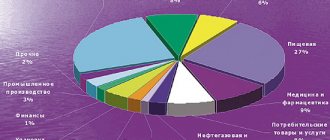From this article you will learn:
- Real investments and their types
- Real investment goals
- Objects and subjects of real investments
- Forms of real investments
- Individuals and legal entities in real investments
- Real investment management
- Advantages and disadvantages of real investments
- Real investments in Russia and abroad
- Conclusion
What is real investment
Let's start with the fact that all investments, depending on what a person invests in, are divided into real and (no, not unreal) financial investments.
Financial include investing money in financial instruments, that is, stocks, bonds, futures, etc.
Real include investments of funds not in the financial, but in the real sector of the economy: in production, in machines, equipment, in raw materials, real estate, modernization of equipment, technical re-equipment of production and many other processes, etc.
Real investment is the investment of money in the support and development of material production, and such investments can be both tangible and intangible.
Financing methods
Methods of financing an investment project attract investment in investments and ensure the financial implementation of the project.
Main methods of financing investment projects:
- self-financing, that is, investing with your own funds;
- corporatization and other types of equity financing;
- credit financing (issue of bonds, investment loans from banks);
- leasing;
- budget financing;
- project financing;
- mixed financing (combination of different methods).
The structure of the real investment market consists of investments in the following assets:
- Investment in a privatized object.
- Direct investment in the enterprise.
- Investing in real estate.
- Investments in precious stones and metals, collectibles.
Real investment for individuals
Individuals can make real investments in various ways:
- Purchase real estate, land and then rent it out. Or wait until the value of the property increases and sell it for much more;
- Purchase any equipment and also rent it out. Or wait until the price of the equipment increases and sell it for much more. Only here it is important not to wait, otherwise new technologies can completely devalue all your equipment;
- Register your right to any intellectual property that will generate income in the future;
- Invest in precious metals or stones, collectibles, etc.
- Organize your own company.
The first 4 types of real investment can be carried out by any individual with or without status. Drawing up the documents necessary to carry out these types of activities does not take much work, so you do not need to hire an accountant, you can do everything yourself.
But when you create your own company, the opportunities for real investment become much greater, but the responsibility for taxes and accounting also increases, so you will have to hire an accountant. Usually in such cases an LLC is already registered.
Determination of effectiveness
To determine the economic efficiency of real investments, dynamic and static methods are used:
| Dynamic Methods | Static methods |
| Net present value | Payback period of investment |
| Return on Investment Index | |
| Internal rate of return | Return on Investment Efficiency Ratio |
| Discounted payback period |
It is considered the most understandable and most often used in practice method of determining the rate of return from an investment object, which is carried out in comparison with other similar investment options. When the rate of return is higher for the research object, such an investment project is considered effective.
Real investment for legal entities
Before you start investing, it is worth remembering that this is done by professionals! From an investor, such investments require knowledge in the field of labor management, knowledge of markets for goods and services and the specifics of their expansion, knowledge and skills in the field of financial investments and financial management, and much more. Otherwise, there is a huge risk of losing all your investments!
In order to start making real investments, you need to take into account risks, write business plans, and calculate the rate of return, payback time and many different parameters. Well, if you deal with this matter seriously and thoroughly. It seems difficult, but I will try to describe the main points that will help you navigate real investing if you still want to do it.
Firstly, if you have your own enterprise/firm, you will have to make real investments in any case, because it is this kind of investment, unlike financial ones, that gives you huge competitive advantages, especially over time.
Secondly, in Russia there is Federal Law No. 39-FZ “On investment activities in the Russian Federation, carried out in the form of capital investments.” Before making real investments, you can familiarize yourself with this law, so that later there will be no questions either to the law or to yourself. He is not big.
Thirdly, you need to understand what goals you are pursuing when making real investments.
Objectives of real investment:
- Sometimes real investment is necessary when you simply cannot do without it in order to stay afloat - laws or circumstances dictate. An example of such an investment could be increasing the environmental safety of an enterprise and reducing the toxicity of waste, which the state may legally require of a company.
If these requirements are not met, it will be impossible to carry out activities in principle, so such investments become mandatory and necessary. The same investments include improving the working conditions of workers, if this is also required by the state by law.
- Increasing the efficiency of the enterprise. In order for a company to remain competitive, its equipment, technological processes, conditions and work procedures for employees also need to be changed and improved. For example, it often happens that you come to work in an organization (as a hired worker or simply to perform some technical or programming work), and the computers there are so old that managers do several hours of work that requires time, in a good way, several hours. minutes, half an hour, maximum hour. Efficiency is extremely low, and without updating the technical base, no matter how hard you try to train managers to work faster, nothing will work.
- If you are going to conquer new markets or increase your company's share in the current market, you will often have to make real investments to expand production volumes. If you produce a tangible product, then this is an absolute necessity for your business.
- If you are going to create a completely new product or a completely new service and want to create a new enterprise for this, then you will make real investments in creating new production facilities.
When you decide on the goals that you are pursuing in your enterprise and for the sake of which you are going to make real investments, it is worth studying the main forms of real investment.
Kinds
Investments in real production can be tangible and intangible (potential):
| Material | Intangible |
| Creation of a new company | Advertising campaign |
| Expansion and modernization of production processes | Trademark (brand) recognition |
| Financing production costs | Improvement of employee qualifications |
| Construction of new production facilities and buildings | Scientific and research developments |
| Improving medical care for staff |
In economic theory, real investments are classified into:
- pure, the main goal of which is to increase fixed capital and create a new fixed capital and part of the working capital (productive or non-productive) fund;
- gross, which differ from net investments in the amount of one-time expenses for production.
In addition, there are external and internal real investments. Most often, investments are aimed at increasing the positive impact of external circumstances on the work of a particular enterprise and increasing production capabilities.
External capital investments refer to profitable investments of capital in production structures, which simultaneously increase the competitiveness of the company. Internal investments develop the strategic potential of the enterprise, increasing technical, technological, intellectual and other resources.
Forms of real investments
- Purchase of full-fledged property complexes . This is usually the acquisition by a large enterprise of another, new enterprise entirely, with all its buildings, structures, technological processes, equipment, etc. This allows the organization that has purchased an entire property complex to diversify its business, enter new markets, produce new goods or provide new services.
Recently, due to the large number of bankruptcies, this form of real investment has become very popular, because it is during the bankruptcy of an enterprise that you can purchase it at a minimal cost, but at the same time, in order for this enterprise to continue to work, you need to invest a huge amount of money in it . But the infrastructure and clients already exist.
- Construction of new buildings, facilities, infrastructure . An enterprise resorts to this form of real investment when there is neither the opportunity nor the desire to buy something that already exists in other enterprises. But there is a desire to expand, develop new markets and expand the share of existing ones, and open new branches. Such real investment is carried out if the company plans and sees all the prerequisites for stable and strong growth.
- Reconstruction . This type of real investment is used when your production needs re-equipment, technological re-equipment, or when old buildings do not correspond to the new technologies that you want to apply in production, and then you need to reconstruct existing buildings, structures, technological processes, etc.
Thanks to reconstruction, you can master new technologies for your production, improve the quality of your products, and increase your production potential.
This is a very useful form of real investment, which is systematically carried out by modern developed and successful companies. Often in Russia, neither buildings nor technological processes know what new technologies are and what benefits they can have for production. Therefore, Russian companies usually lag far behind the world's leading companies in development.
- When talking about reconstruction, repurposing , that is, a complete change of all technological processes to produce completely new products.
- Modernization is a form of real investment in which all production capacities of an enterprise, that is, its machines, equipment, etc., are brought into full compliance with the times, with modern new technologies. This is also an extremely useful form of real investment, since it subsequently provides very high efficiency of working time and, in general, all the resources that the enterprise has.
- Purchase of certain types of tangible assets . This form of investment is not associated with a complete “change of shoes” of one’s production, but with the acquisition of individual machines, machine tools, raw materials, and any goods. On the one hand, old machines/raw materials were replaced, and huge amounts of money did not have to be spent on all this. Often such partial real investment is carried out either in connection with the wear and tear of production facilities, or in connection with an increase in production volumes.
- Investments in innovative intangible assets . This is the purchase of new patents, trademarks, licenses, new knowledge, etc., which will pay off and bring profit in the future. This new knowledge and technology can either be developed independently or purchased.
These are the forms of real investment that a legal entity can carry out. Everyone will choose the forms that are suitable specifically for him, his enterprise, but it is worth remembering that real investment, often unlike financial investment, pays off very well, gives a huge impetus to the development of your business, your enterprise, while there are relatively few risks in real investment, it is reliable form of investment. But they are most often expensive.
Let's summarize all of the above and highlight the main features, pros and cons of real investments.
Franchising - advantages and disadvantages
You can start your business from scratch, gradually develop and expand your project. Or you can buy a franchise and open a branch of an already well-known company. This will allow you to start your business under a well-known brand with a recognizable product. Buying a franchise gives you access to trusted suppliers, help and advice from the parent company, but all this comes at a high price of entry.
Buying a franchise from little-known companies will cost 200-300 thousand rubles. And well-known brands start from 10-20 million rubles.
For example, to purchase a McDonald's franchise you will need from 10 to 40 million rubles and the fulfillment of a large number of requirements. But buying a Pyaterochka store franchise costs only 1 million rubles.
Features of real investments, their pros and cons
- Real investments do not depreciate in value the way a national currency does. If the exchange rate can jump back and forth, and the value of money among the population, accordingly, too, then the value of real investment objects does not jump anywhere at such a pace.
For example , for individuals who bought apartments for renting or resale: the apartment gradually increases in price, and its growth rate often exceeds the rate of inflation in a stable economy. An apartment does not depreciate in value like currency. Real business investments also give a huge impetus to its development, outpacing inflation for a long time.
- Real investments carry fewer risks (an apartment will most likely always cost a lot of money, a machine or machine will most likely work for a long time and cost a lot). You don’t need to risk an apartment or a machine, a patent, like a financial instrument on the market.
If you have made real investments, you see them in a material form, and real investments do not carry any “air” like in the market.
- At the same time, the return on real investment is high . This is not a minimum percentage in the bank, not dubious and incomprehensible management of your assets, this is a real increase in production efficiency that brings you profit every day. Perhaps not right away, but in the future, yes.
- It is with the help of real, rather than financial, investments that a business has the opportunity to develop faster, more efficiently, better, and wider . New technologies will increase production efficiency, new equipment will allow you to produce higher quality products, which means you will have more customers and, accordingly, you will be able to earn more money.
- Real investment objects can quickly become obsolete due to rapid technological progress. It seems that they updated the equipment, improved the technological processes, and while all this was being implemented and developed, the competitor had already bought something more technologically advanced, because suddenly a completely new technology appeared on the market. It may be like that. Therefore, real objects require continuous investment and support.
- Real investment objects are very illiquid. While any financial instruments can, in principle, be sold very quickly (except for crisis and stagnation), equipment, especially equipment that has already been in use, most often cannot be sold quickly.
Or the purchased raw materials may not have time to be sold or sold, and they will deteriorate. But there will be nothing for financial instruments, and they will also sell faster on any free financial market.
If you have already firmly determined that you want to make real investment in your organization, then you need to understand through what means this real investment can be made.
Sources of real investment
Federal Law No. 39-FZ talks about the following sources of capital investment:
- Investing from your own funds;
- Investment using raised funds.
An example of funds raised is, for example, income from the sale of shares, additional contributions to the authorized capital, etc. That is, this is not a loan, not a loan. Raised funds do not require interest payments, but they also need to be “paid for” in a certain way (for example, for shares - with dividends).
Thus, investing through loans is not a good idea. What if the project fails? Not only does real investment often take years to pay off, and you need to pay for the loan now, but there is also a risk of incomplete realization of your investments. And banks, as you know, are not interested in your problems. Therefore, it is better to either save up for real investment or look for raised funds for your business.
Real investment management
Management of real investments is carried out in the organization by specialists, since this process requires certain knowledge and skills.
The management process includes the following stages:
- Conducting an analysis to determine whether there is real investment in the business. That is, it is required to study the past investment experience of the organization if it was:
- What investments were made, and what part of the total investment is actually invested;
- How did the volume of real investment change previously and why?
- To what extent have real investment projects been implemented?
- To what extent have the invested funds been utilized?
- How complete/unfinished are investment projects and how many more resources are needed to complete them;
- How effective were the previously made real investments, how much did they correspond to the set goals and desired parameters.
- Based on the experience learned, the volume of real investments that you want to implement in the future is then determined . This desired volume comes from how much and what you want to change in your business.
- Determining the form of real investment that you want to apply/implement in your business. This was written about above.
- Selection and search for such investment projects, investment directions , investment objects that would correspond to the goals that you want to achieve in the investment process, as well as the forms of investment you previously determined.
At this stage:
- The proposals that are currently available on the investment market are studied, and the ones most relevant to the business and its capabilities are selected;
- The necessary investment objects are selected;
- A thorough analysis of all selected investment objects is carried out.
Almost all forms of large-scale investments (except for minor investments due to wear and tear of equipment) are considered as investment projects. For investment projects, a detailed business plan must be drawn up.
- Selected investment projects are analyzed for their effectiveness. In parallel with this, all possible risk factors inherent in this particular project are also analyzed, as well as the correspondence of the level of risks to the level of profitability of the project.
When analyzing possible risks, the main indicators of the project are taken and changed in a negative direction. At the same time, the sensitivity of the project to such negative changes is analyzed. Such modeling of possible risks allows the investor to understand how the project’s performance and the overall possibility of its implementation may change. And also later, during the actual implementation of this project, it is good to navigate all the scenarios for its implementation.
At the same stage, the risks of reducing the solvency of the organization as a whole are considered: money is needed for real investments, they are taken from any other possible areas of activity of the enterprise or from reserves, and this diversion of funds is quite long, so the overall solvency of the enterprise can significantly decrease.
- A real investment program is being drawn up.
All possible options for investment projects at this stage of real investment management are classified according to possible profitability, risk, investment objectives, liquidity, etc. Based on the fact that the total volume of investments is in any case limited, the most profitable projects are selected that will contribute its most active development. It is these projects that will be included in the future investment program.
- The stage of implementation of the investment program and all projects included in it.
The investment program is implemented using tools such as:
- A specific project financing scheme;
- Project financing schedule;
- Capital budget.
Each instrument performs its own function, and with the help of a combination of these instruments, the implementation of the investment program will not take long.
- All investment projects and the investment program as a whole are constantly monitored , and the main performance indicators of the projects and the entire program are analyzed.
Here is a simple scheme for managing real investments. Managing real investments in an organization is not an easy thing, and every investor, deciding to take such a step, must understand what, in addition to headaches, he will get from this whole process.











